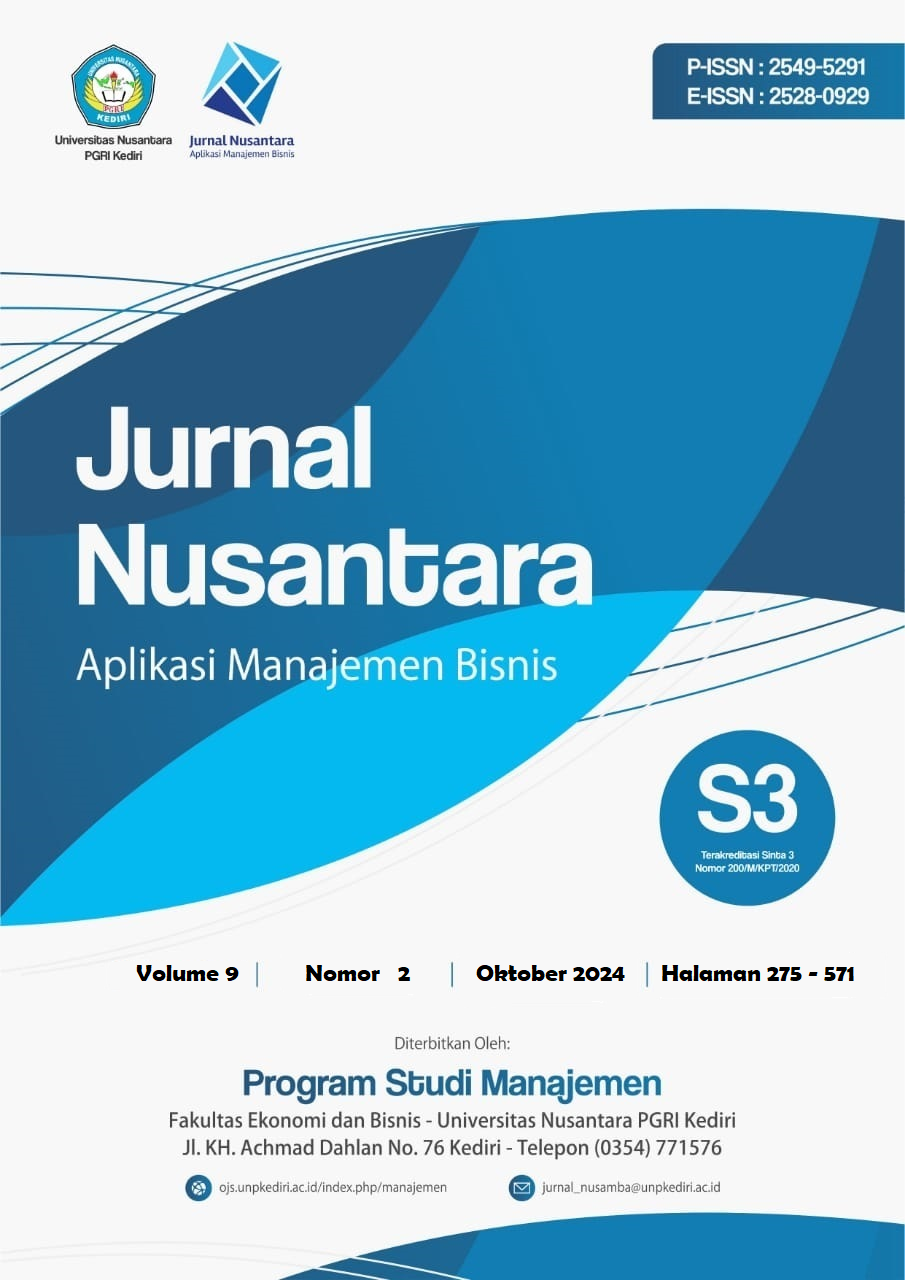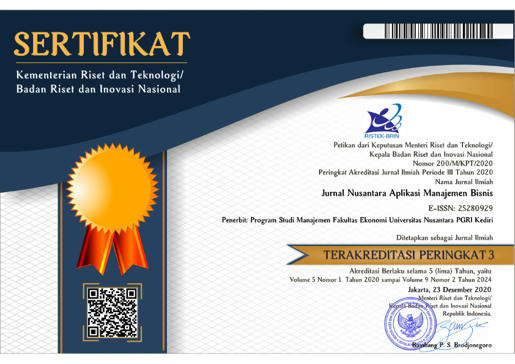Analisis Perilaku Generasi Z dalam Mengadopsi Bank Digital : Pendekatan TAM dan S-O-R
DOI:
https://doi.org/10.29407/nusamba.v9i2.20879Keywords:
Bank Digital, Gen-Z, TAMAbstract
Research aim: The purpose of this study is to determine the factors that influence the adoption of digital banks based on the concept of the Technology Acceptance Model (TAM) in gen-Z.
Methods: The data analysis technique uses Structural Equation Modeling (SEM) inferential analysis with WarpPLS 8.0.
Research Finding: The results of this study revealed that perceived ease of use (PEOU) and perceived usefulness (PU) have a positive and significant on attitudes (ATT). PEOU indirectly has a positive and significant on PU. PU has a positive and significant effect on behavioral intention (BI). ATT directly has a positive and significant on BI in digital bank adoption.
Theoretical contribution: TAM can be applied to measure gen-Z behavior in digital bank adoptions.
Practitioner/Policy implication: Digital bank management should consider usability and user-friendliness factors as stimuli for attitudes that generate behavioral intentions towards digital bank adoption, specifically among Gen-Z. This generation serves as a potential target market for digital banking services marketing. The results of this study can drive innovation in digital banking products and services, enhancing operational efficiency for banks.
Research limitation: The results of this study are only specific to gen-Z and cannot be generalized
Downloads
References
Cupian, Valentino U, Noven SA. Analisis Faktor-Faktor Yang Mempengaruhi Minat Menggunakan Bank Digital Syariah pada Generasi Z: Studi Kasus di Kota BOgor. Jurnal Ilmiah Ekonomi Islam 2022;8:1678–88.
Wijaya IGNS, Ekayasa MD. Perilaku Keputusan Pembelian Generasi Y dan Z dalam Penggunaan E-Commerce di Masa Pasca Pandemi. Jurnal Nusantara Aplikasi Manajemen Bisnis 2022;7:338–57. https://doi.org/10.29407/nusamba.v7i2.18357.
Yip AWH, Bocken NMP. Sustainable Business Model Archetypes for The Banking Industry. J Clean Prod 2018;174. https://doi.org/10.1016/j.jclepro.2017.10.190.
Mbama CI, Ezepue PO. Digital Banking, Customer Experience and Bank Financial Performance: UK Customers’ Perceptions. International Journal of Bank Marketing 2018;36:230–55. https://doi.org/10.1108/IJBM-11-2016-0181.
Nurmaliki S, Mirza M. Factors Affecting the Intention to Adopt Digital Banking by Digital Saving Customers (Case Study of Syariah Mandiri Bank). Int J Innov Sci Res Technol 2021;6:504–13.
Otoritas Jasa Keuangan. Peraturan Otoritas Jasa Keuangan Republik Indonesia Nomor 12/POJK.03/2021 tentang Bank Umum. WwwOjkGoId 2021:1–113. https://sikepo.ojk.go.id/SIKEPO/DatabasePeraturan/PeraturanUtuh/84c36c57-c4bb-4815-9b13-c229.
Otoritas Jasa Keuangan. POJK Nomor 12/POJK.03/2018 Tentang Penyelenggaraan Layanan Perbankan Digital Oleh Bank Umum. 2018.
Hafizha Z, Anggraini T. Pengaruh Personal Branding Sumber Daya Insani Perbankan Syariah Terhadap Digitalisasi Banking di Era Industri 4.0. Jurnal Ilmiah Ekonomi Islam 2023;9:470–9. https://doi.org/10.29040/jiei.v9i1.7942.
He D, You K, Li W, Wu J. Determinants of Technology Adoption: Evidence from the Chinese Banking Industry. Emerging Markets Finance and Trade 2021;57:1–23. https://doi.org/10.1080/1540496X.2019.1678027.
Windasari NA, Kusumawati N, Larasati N, Amelia RP. Digital-Only Banking Experience: Insights From Gen Y and Gen Z. Journal of Innovation and Knowledge 2022;7:1–10. https://doi.org/10.1016/j.jik.2022.100170.
Badan Pusat Statistik. Hasil Sensus Penduduk 2020 Indonesia. 2021.
Dolot A. The Characteristics of Generation Z. E-Mentor 2018;2:44–50.
Francis T, Hoefel F. “True Gen”: Generation Z and Its Implications for Companies. 2018.
Juaneé Cilliers E. The Challenge of Teaching Generation Z. PEOPLE: International Journal of Social Sciences 2017;3:188–98. https://doi.org/10.20319/pijss.2017.31.188198.
Dootson P, Beatson A, Drennan J. Financial Institutions Using Social Media – Do Consumers Perceive Value? International Journal of Bank Marketing 2016;34. https://doi.org/10.1108/IJBM-06-2014-0079.
Csobanka ZE. The Z Generation. Acta Technologica Dubnicae 2016;6:63–76. https://doi.org/10.1515/atd-2016-0012.
Rodrigues Filipe L, Rodrigues H, Oliveira A. In Times of Pandemic - How Generation XYZ Looks at Digital Banking. Usability and User Experience, vol. 39, 2022, p. 458–66. https://doi.org/10.54941/ahfe1001742.
Singh AP, Dangmei J. Understanding The Generation Z: The Future Workforce. South -Asian Journal of Multidisciplinary Studies 2016;3:1–5.
Indriyarti ER, Christian M, Yulita H, Aryati T, Arsjah RJ. Digital Bank Channel Distribution: Predictors of Usage Attitudes in Jakarta’s Gen Z. Journal of Distribution Science 2023;21:21–34. https://doi.org/10.15722/jds.21.02.202302.21.
Nurahmasari M, Nur Silfiyah S, Haposan Pangaribuan C. The Intention to Use Digital Banking Services among Gen Z in Indonesia Based on Technology Acceptance Model (TAM). Jurnal Manajemen Dan Bisnis Madani 2023;5:15–31. https://doi.org/10.51353/jmbm.v5i1.692.
Sihotang ET, Murdiawati D. Acceptance of Internet Banking Services: The Role of Demographic Factors as Moderating Variables. Jurnal Ekonomi Dan Bisnis 2022;25:153–76. https://doi.org/10.24914/jeb.v25i1.4513.
Fishbein M, Ajzen I. Belief, Attitude, and Behaviour: An Introduction to Theory and Research. 1975.
Ajzen I. Martin Fishbein’s Legacy: The Reasoned Action Approach. Annals of the American Academy of Political and Social Science 2012;640:11–27. https://doi.org/10.1177/0002716211423363.
Davis FD. Perceived Usefulness, Perceived Ease of Use, and User Acceptance of Information Technology. MIS Q 1989;13:319–40. https://doi.org/10.2307/249008.
Davis FD. User Acceptance of Information Technology: System Characteristics, User Perceptions and Behavioral Impacts. International Journal Man-Machine Studies 1993;38:475–87.
Alnemer HA. Determinants of Digital Banking Adoption in the Kingdom of Saudi Arabia: A Technology Acceptance Model Approach. Digital Business 2022;2:100037. https://doi.org/10.1016/j.digbus.2022.100037.
Adiatama MH, Lestari DT. Persepsi Milenial Terhadap Layanan Mobile Payment Di Indonesia Dengan Menggunakan Pendekatan Technology Acceptance Model (TAM). E-Proceeding of Management 2020;7:4190–205.
Riza AF. Customer Acceptance of Digital Banking in Islamic Bank: Study on Millennial Generation. Conference on Islamic Management, Accounting, and Economics (CIMAE) Proceeding 2019;2:66–74.
Tanika C, William, Hartanto MP, Tanjung M. Factors Influencing Indonesian Consumers to Use Digital Banking. Proceedings - The 4th International Conference on Informatics, Multimedia, Cyber and Information System, ICIMCIS 2022, 2022, p. 546–51. https://doi.org/10.1109/ICIMCIS56303.2022.10017694.
Davis FD, Venkatesh V. A Critical Assessment of Potential Measurement Biases in the Technology Acceptance Model: Three Experiments. International Journal of Human Computer Studies 1996;45:19–45. https://doi.org/10.1006/ijhc.1996.0040.
Mufarih M, Jayadi R, Sugandi Y. Factors Influencing Customers to Use Digital Banking Application in Yogyakarta, Indonesia. Journal of Asian Finance, Economics and Business 2020;7:897–907. https://doi.org/10.13106/jafeb.2020.vol7.no10.897.
Mansour IHF, Eljelly AMA, Abdullah AMA. Consumers’ Attitude Towards E-Banking Services in Islamic Banks: The Case of Sudan. Review of International Business and Strategy 2016;26:224–60. https://doi.org/10.1108/RIBS-02-2014-0024.
Mehrabian A, Russell JA. An Approach to Environmental Psychology. Cambridge, MA: MIT Press; 1974.
Islam JU, Rahman Z, Hollebeek LD. Personality factors as predictors of online consumer engagement: an empirical investigation. Marketing Intelligence and Planning 2017;35:510–28. https://doi.org/10.1108/MIP-10-2016-0193.
Chen CC, Yao JY. What Drives Impulse Buying Behaviors in a Mobile Auction? The Perspective of the Stimulus-Organism-Response Model. Telematics and Informatics 2018;35:1249–62. https://doi.org/10.1016/j.tele.2018.02.007.
Cooper DR, Schindler PS. Business Research Methods 12th Edition. Twelfth Ed. New York: McGraw-Hill Companies, Inc, NY; 2014.
Handayani R. Metodologi Penelitian Sosial Ekonomi. Cetakan I. Yogyakarta: Trussmedia Grafika; 2020.
Hair JF, Hult GTM, Ringle CM, Sarstedt M. A Primer on Partial Least Squares Structural Equation Modeling (PLS-SEM). Second Edition. Thousand Oaks, California: SAGE Publications, Inc; 2017.
Hair JF, Black WC, Babin BJ, Anderson ER. Multivariate Data Analysis. Eighth. Hampshire: Pearson Education, Inc; 2019.
Nguyen OT. Factors Affecting the Intention to Use Digital Banking in Vietnam. Journal of Asian Finance, Economics and Business 2020;7:303–10. https://doi.org/10.13106/jafeb.2020.vol7.no3.303.
Downloads
Published
Issue
Section
License
Authors who publish with this journal agree to the following terms:
- Copyright on any article is retained by the author(s).
- The author grants the journal, the right of first publication with the work simultaneously licensed under a Creative Commons Attribution License that allows others to share the work with an acknowledgment of the work’s authorship and initial publication in this journal.
- Authors are able to enter into separate, additional contractual arrangements for the non-exclusive distribution of the journal’s published version of the work (e.g., post it to an institutional repository or publish it in a book), with an acknowledgment of its initial publication in this journal.
- Authors are permitted and encouraged to post their work online (e.g., in institutional repositories or on their website) prior to and during the submission process, as it can lead to productive exchanges, as well as earlier and greater citation of published work.
- The article and any associated published material is distributed under the Creative Commons Attribution-ShareAlike 4.0 International License












